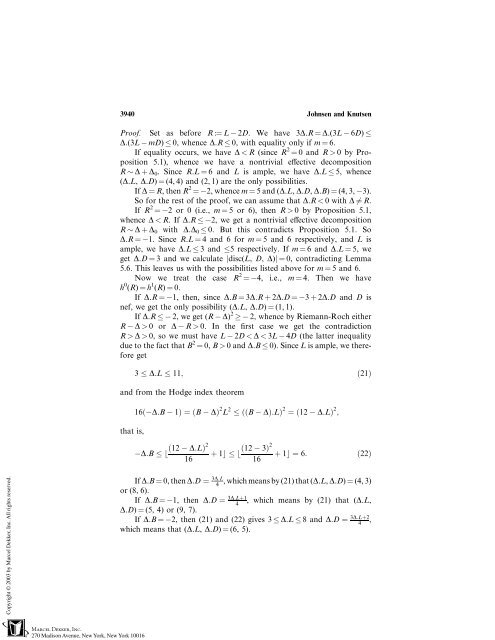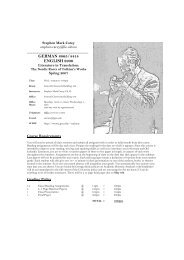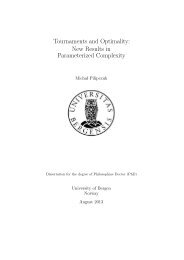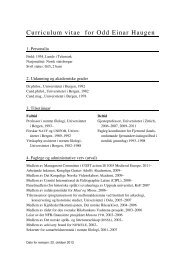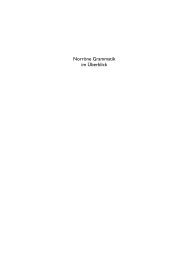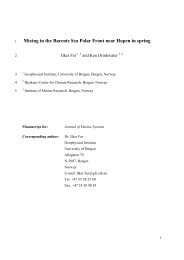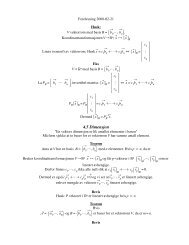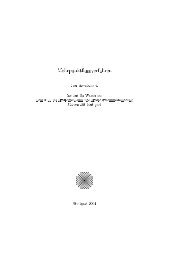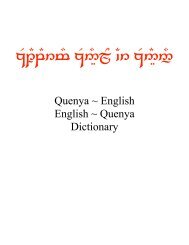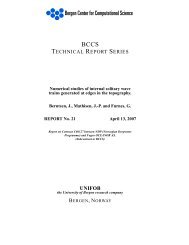Rational Curves in Calabi-Yau Threefolds
Rational Curves in Calabi-Yau Threefolds
Rational Curves in Calabi-Yau Threefolds
Create successful ePaper yourself
Turn your PDF publications into a flip-book with our unique Google optimized e-Paper software.
3940 Johnsen and Knutsen<br />
Proof. Set as before R :¼ L 2D. We have 3D.R ¼ D.(3L 6D)<br />
D.(3L mD) 0, whence D.R 0, with equality only if m ¼ 6.<br />
If equality occurs, we have D < R (s<strong>in</strong>ce R 2 ¼ 0andR > 0 by Proposition<br />
5.1), whence we have a nontrivial effective decomposition<br />
R D þ D0. S<strong>in</strong>ce R.L ¼ 6 and L is ample, we have D.L 5, whence<br />
(D.L, D.D) ¼ (4, 4) and (2, 1) are the only possibilities.<br />
If D ¼ R, then R 2 ¼ 2, whence m ¼ 5and(D.L, D.D, D.B) ¼ (4, 3, 3).<br />
So for the rest of the proof, we can assume that D.R < 0 with D 6¼ R.<br />
If R 2 ¼ 2 or 0 (i.e., m ¼ 5 or 6), then R > 0 by Proposition 5.1,<br />
whence D < R. IfD.R 2, we get a nontrivial effective decomposition<br />
R D þ D0 with D.D0 0. But this contradicts Proposition 5.1. So<br />
D.R ¼ 1. S<strong>in</strong>ce R.L ¼ 4 and 6 for m ¼ 5 and 6 respectively, and L is<br />
ample, we have D.L 3and5 respectively. If m ¼ 6 and D.L ¼ 5, we<br />
get D.D ¼ 3 and we calculate jdisc(L, D, D)j¼0, contradict<strong>in</strong>g Lemma<br />
5.6. This leaves us with the possibilities listed above for m ¼ 5 and 6.<br />
Now we treat the case R 2 ¼ 4, i.e., m ¼ 4. Then we have<br />
h 0 (R) ¼ h 1 (R) ¼ 0.<br />
If D.R ¼ 1, then, s<strong>in</strong>ce D.B ¼ 3D.R þ 2D.D ¼ 3 þ 2D.D and D is<br />
nef, we get the only possibility (D.L, D.D) ¼ (1, 1).<br />
If D.R 2, we get (R D) 2<br />
2, whence by Riemann-Roch either<br />
R D > 0 or D R > 0. In the first case we get the contradiction<br />
R > D > 0, so we must have L 2D < D < 3L 4D (the latter <strong>in</strong>equality<br />
due to the fact that B 2 ¼ 0, B > 0 and D.B 0). S<strong>in</strong>ce L is ample, we therefore<br />
get<br />
3 D:L 11; ð21Þ<br />
and from the Hodge <strong>in</strong>dex theorem<br />
that is,<br />
16ð D:B 1Þ ¼ðB DÞ 2 L 2<br />
ððB DÞ:LÞ 2 ¼ð12 D:LÞ 2 ;<br />
ð12 D:LÞ2 ð12 3Þ2<br />
D:B b þ 1c b þ 1c ¼6: ð22Þ<br />
16<br />
16<br />
If D.B ¼ 0, then D:D ¼ 3D:L<br />
4 , which means by (21) that (D.L, D.D) ¼ (4, 3)<br />
or (8, 6).<br />
If D.B ¼ 1, then D:D ¼ 3D:Lþ1<br />
4 , which means by (21) that (D.L,<br />
D.D) ¼ (5, 4) or (9, 7).<br />
If D.B ¼ 2, then (21) and (22) gives 3 D.L 8 and D:D ¼ 3D:Lþ2<br />
4 ,<br />
which means that (D.L, D.D) ¼ (6, 5).


